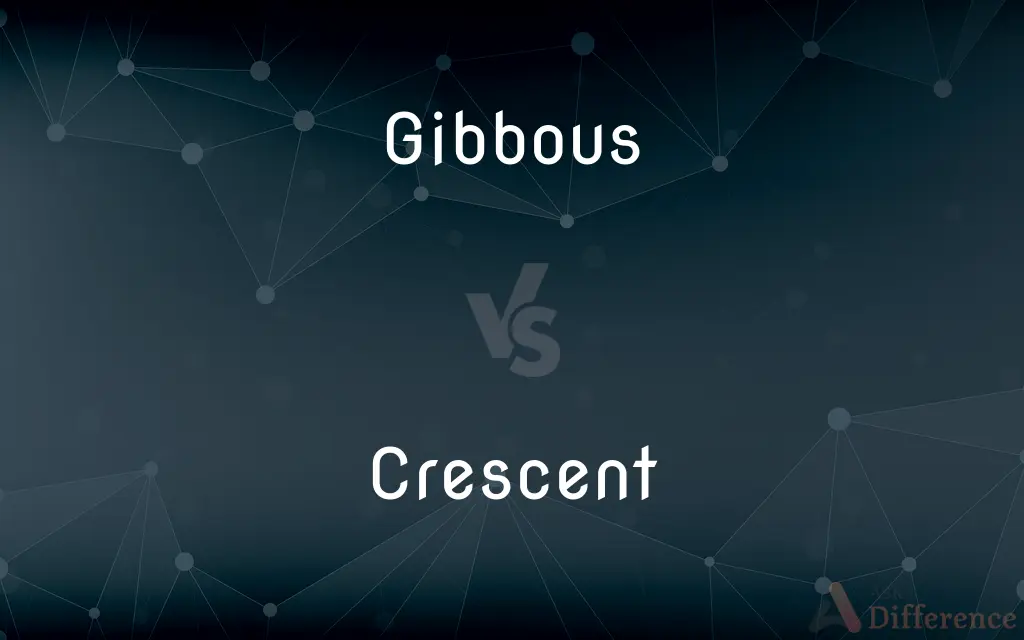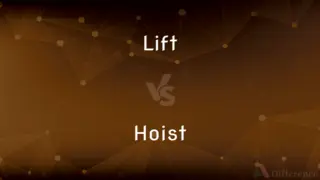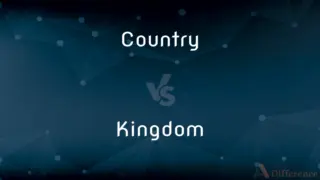Gibbous vs. Crescent — What's the Difference?
By Fiza Rafique & Urooj Arif — Updated on April 25, 2024
Gibbous moons are more than half illuminated, appearing convex, while crescent moons show less than half, creating a concave arc.

Difference Between Gibbous and Crescent
Table of Contents
ADVERTISEMENT
Key Differences
A gibbous moon occurs when the Moon is more than half illuminated, often appearing swollen on one side. Whereas, a crescent moon is characterized by its slim, curved shape, showing less than half of its surface illuminated.
In the gibbous phase, the moon is approaching fullness, leading to increased brightness at night. On the other hand, the crescent phase follows or precedes a new moon, resulting in less moonlight and darker nights.
The visibility of a gibbous moon can often facilitate night-time activities due to its brightness, while the minimal light from a crescent moon enhances the visibility of stars and other celestial bodies.
Crescent moons are often associated with symbolism in various cultures, representing new beginnings or change. The gibbous moon's extensive illumination makes it less ideal for astronomical observations, as the brightness can obscure faint stars.
Comparison Chart
Illumination
More than half of the moon is illuminated
Less than half of the moon is illuminated
ADVERTISEMENT
Shape
Appears convex, bulging outward
Appears concave, curving inward
Visibility
Bright, easily visible in the night sky
Dimmer, less visible compared to gibbous
Symbolism
Less symbolic in cultures
Often symbolizes new beginnings
Astronomical Impact
Brightness interferes with star viewing
Ideal for stargazing due to low brightness
Compare with Definitions
Gibbous
Relating to the moon in the phase following the first quarter and preceding the full moon.
We scheduled the observation when the moon was gibbous.
Crescent
Provides minimal nighttime illumination.
Under the crescent moon, the stars seemed brighter.
Gibbous
More than half but not fully illuminated.
The gibbous moon cast a soft glow over the landscape.
Crescent
Shaped like a bow or arc.
I captured the perfect picture of the crescent moon.
Gibbous
Swollen in appearance.
The moon appeared unusually gibbous tonight.
Crescent
Less than half of the moon is illuminated.
The crescent moon hung like a silver bow in the sky.
Gibbous
Illuminating most of the night.
A gibbous moon means less reliance on artificial lights outdoors.
Crescent
Often used as a symbol in various cultures.
The crescent moon is prominent in many national flags.
Gibbous
Less favorable for astronomers.
A gibbous moon phase can obscure the fainter stars in the sky.
Crescent
Relating to the moon either before the first quarter or after the last quarter.
They planned the ritual for the night of the crescent moon.
Gibbous
Characterized by convexity; protuberant
A gibbous seashell.
Crescent
A crescent shape (, British English also ) is a symbol or emblem used to represent the lunar phase in the first quarter (the "sickle moon"), or by extension a symbol representing the Moon itself. In Hinduism, Lord Shiva is often shown wearing a crescent moon on his head symbolising that the lord is the master of time and is himself timeless.
Gibbous
More than half but less than fully illuminated from the point of view of an observer. Used of phases of the moon or the planets.
Crescent
The curved sickle shape of the waxing or waning moon
The moon was a slender crescent
Gibbous
(Archaic) Having a hump; humpbacked.
Crescent
A thing which has the shape of a single curve that is broad in the centre and tapers to a point at each end
A three-mile crescent of golden sand
Gibbous
Characterized by convexity; protuberant.
Crescent
A moth or butterfly with crescent-shaped markings on the wings.
Gibbous
Having more than half (but not the whole) of its disc illuminated.
Crescent
Having the shape of a crescent
A crescent moon
Gibbous
Humpbacked.
Crescent
Growing, increasing, or developing.
Gibbous
Swelling by a regular curve or surface; protuberant; convex; as, the moon is gibbous between the half-moon and the full moon.
The bones will rise, and make a gibbous member.
Crescent
The figure of the moon as it appears before its first quarter phase or after its third quarter phase, with concave and convex edges terminating in points.
Gibbous
Hunched; hump-backed.
Crescent
A curved street.
Gibbous
Characteristic of or suffering from kyphosis, an abnormality of the vertebral column
Crescent
A curved block of buildings, especially row houses, forming a continuous facade.
Gibbous
(used of the moon) more than half full
Crescent
A curved pastry.
Crescent
Crescent-shaped.
Crescent
Waxing, as the moon approaching its first quarter phase; increasing.
Crescent
The figure of the moon as it appears between its first or last quarter and the new moon, with concave and convex edges terminating in points.
Crescent
Something shaped like a crescent, especially:
Crescent
A curved pastry.
Crescent
A curved street, often presenting a continuous façade, as of row houses.
Crescent
(Islam) A representation of crescent used as a symbol of Islam.
Turkish flag features a white star and crescent on red base.
Crescent
(NZ) A crescent spanner.
Crescent
(historical) Any of three orders of knighthood conferred upon foreigners to whom Turkey might be indebted for valuable services.
Crescent
(heraldry) The emblem of the waxing Moon with horns directed upward, when used in a coat of arms; often used as a mark of cadency to distinguish a second son and his descendants.
Crescent
A crescentspot butterfly.
Crescent
Marked by an increase; waxing, like the Moon.
Crescent
Shaped like a crescent.
Crescent
(transitive) To form a crescent shape
Crescent
(transitive) To decorate with crescents.
Crescent
The increasing moon; the moon in her first quarter, or when defined by a concave and a convex edge; also, applied improperly to the old or decreasing moon in a like state.
Crescent
Anything having the shape of a crescent or new moon.
Crescent
A representation of the increasing moon, often used as an emblem or badge
The cross of our faith is replanted,The pale, dying crescent is daunted.
Crescent
Any one of three orders of knighthood; the first instituted by Charles I., king of Naples and Sicily, in 1268; the second by René of Anjou, in 1448; and the third by the Sultan Selim III., in 1801, to be conferred upon foreigners to whom Turkey might be indebted for valuable services.
Crescent
The emblem of the increasing moon with horns directed upward, when used in a coat of arms; - often used as a mark of cadency to distinguish a second son and his descendants.
Crescent
Shaped like a crescent.
Astarte, queen of heaven, with crescent horns.
Crescent
Increasing; growing.
O, I see the crescent promise of my spirit hath not set.
Crescent
To form into a crescent, or something resembling a crescent.
Crescent
To adorn with crescents.
Crescent
Any shape resembling the curved shape of the moon in its first or last quarters
Crescent
Resembling the new moon in shape
Common Curiosities
How does moonlight from a gibbous moon affect night visibility?
A gibbous moon, being brightly lit, enhances visibility at night, making it easier to see without additional light sources.
Can the moon be both gibbous and crescent in the same night?
No, the moon cannot be both gibbous and crescent in the same night as these phases occur at different times during the lunar cycle.
What is a crescent moon?
A crescent moon shows less than half of its face illuminated, forming a shape similar to a bow.
How often does the moon's phase change from crescent to gibbous?
The moon's phase changes gradually over a month, cycling through crescent, gibbous, full, and new phases.
What cultural significances does a crescent moon hold?
The crescent moon is a symbol of new beginnings and is featured in various cultural and religious symbols.
What is a gibbous moon?
A gibbous moon is one where more than half of its face is illuminated.
Why is a crescent moon important for stargazing?
With less moonlight during a crescent phase, the sky is darker, which is ideal for observing stars and other celestial objects.
What is the best time to observe a crescent moon?
A crescent moon is best observed just after sunset or before sunrise, depending on whether it is waxing or waning.
How does the appearance of a gibbous and crescent moon differ?
A gibbous moon appears almost fully lit and round, whereas a crescent moon looks like a thin arc or bow.
What phase follows a crescent moon?
A crescent moon is followed by a first quarter moon or leads into a new moon, depending on whether it is waxing or waning.
What activities are better under a gibbous moon?
Activities that require more natural light at night, such as hiking or fishing, are better under a gibbous moon.
Why might an astronomer prefer a crescent moon?
Astronomers prefer a crescent moon due to the reduced moonlight interference, which allows better observation of faint celestial objects.
Is a gibbous moon considered a full moon?
No, a gibbous moon is the phase just before or just after a full moon, where it is mostly but not completely illuminated.
What does a waning crescent moon signify?
A waning crescent moon signifies the end of one lunar cycle and the impending approach of a new moon.
Can the gibbous phase be seen all night?
Depending on the time of the month, a gibbous moon can be visible for most of the night.
Share Your Discovery

Previous Comparison
Lift vs. Hoist
Next Comparison
Country vs. KingdomAuthor Spotlight
Written by
Fiza RafiqueFiza Rafique is a skilled content writer at AskDifference.com, where she meticulously refines and enhances written pieces. Drawing from her vast editorial expertise, Fiza ensures clarity, accuracy, and precision in every article. Passionate about language, she continually seeks to elevate the quality of content for readers worldwide.
Co-written by
Urooj ArifUrooj is a skilled content writer at Ask Difference, known for her exceptional ability to simplify complex topics into engaging and informative content. With a passion for research and a flair for clear, concise writing, she consistently delivers articles that resonate with our diverse audience.
















































